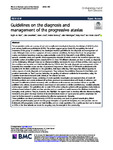Guidelines on the diagnosis and management of the progressive ataxias
| dc.contributor.author | de Silva, R | |
| dc.contributor.author | Greenfield, J | |
| dc.contributor.author | Cook, A | |
| dc.contributor.author | Bonney, H | |
| dc.contributor.author | Vallortigara, J | |
| dc.contributor.author | Hunt, B | |
| dc.contributor.author | Giunti, P | |
| dc.date.accessioned | 2021-08-05T13:12:14Z | |
| dc.date.issued | 2019-12 | |
| dc.identifier.issn | 1750-1172 | |
| dc.identifier.issn | 1750-1172 | |
| dc.identifier.other | 51 | |
| dc.identifier.uri | http://hdl.handle.net/10026.1/17400 | |
| dc.description.abstract |
The progressive ataxias are a group of rare and complicated neurological disorders, knowledge of which is often poor among healthcare professionals (HCPs). The patient support group Ataxia UK, recognising the lack of awareness of this group of conditions, has developed medical guidelines for the diagnosis and management of ataxia. Although ataxia can be a symptom of many common conditions, the focus here is on the progressive ataxias, and include hereditary ataxia (e.g. spinocerebellar ataxia (SCA), Friedreich's ataxia (FRDA)), idiopathic sporadic cerebellar ataxia, and specific neurodegenerative disorders in which ataxia is the dominant symptom (e.g. cerebellar variant of multiple systems atrophy (MSA-C)). Over 100 different disorders can lead to ataxia, so diagnosis can be challenging. Although there are no disease-modifying treatments for most of these entities, many aspects of the conditions are treatable, and their identification by HCPs is vital. The early diagnosis and management of the (currently) few reversible causes are also of paramount importance. More than 30 UK health professionals with experience in the field contributed to the guidelines, their input reflecting their respective clinical expertise in various aspects of ataxia diagnosis and management. They reviewed the published literature in their fields, and provided summaries on "best" practice, including the grading of evidence available for interventions, using the Guideline International Network (GIN) criteria, in the relevant sections.A Guideline Development Group, consisting of ataxia specialist neurologists and representatives of Ataxia UK (including patients and carers), reviewed all sections, produced recommendations with levels of evidence, and discussed modifications (where necessary) with contributors until consensus was reached. Where no specific published data existed, recommendations were based on data related to similar conditions (e.g. multiple sclerosis) and/or expert opinion. The guidelines aim to assist HCPs when caring for patients with progressive ataxia, indicate evidence-based (where it exists) and best practice, and act overall as a useful resource for clinicians involved in managing ataxic patients. They do, however, also highlight the urgent need to develop effective disease-modifying treatments, and, given the large number of recommendations based on "good practice points", emphasise the need for further research to provide evidence for effective symptomatic therapies.These guidelines are aimed predominantly at HCPs in secondary care (such as general neurologists, clinical geneticists, physiotherapists, speech and language therapists, occupational therapists, etc.) who provide care for individuals with progressive ataxia and their families, and not ataxia specialists. It is a useful, practical tool to forward to HCPs at the time referrals are made for on-going care, for example in the community. | |
| dc.format.extent | 51- | |
| dc.format.medium | Electronic | |
| dc.language | en | |
| dc.language.iso | en | |
| dc.publisher | Springer Science and Business Media LLC | |
| dc.subject | Cerebellar Ataxia | |
| dc.subject | Consensus | |
| dc.subject | Female | |
| dc.subject | Humans | |
| dc.subject | Male | |
| dc.subject | Spinocerebellar Degenerations | |
| dc.title | Guidelines on the diagnosis and management of the progressive ataxias | |
| dc.type | journal-article | |
| dc.type | Journal Article | |
| dc.type | Review | |
| plymouth.author-url | https://www.webofscience.com/api/gateway?GWVersion=2&SrcApp=PARTNER_APP&SrcAuth=LinksAMR&KeyUT=WOS:000459383300001&DestLinkType=FullRecord&DestApp=ALL_WOS&UsrCustomerID=11bb513d99f797142bcfeffcc58ea008 | |
| plymouth.issue | 1 | |
| plymouth.volume | 14 | |
| plymouth.publication-status | Published | |
| plymouth.journal | Orphanet Journal of Rare Diseases | |
| dc.identifier.doi | 10.1186/s13023-019-1013-9 | |
| plymouth.organisational-group | /Plymouth | |
| plymouth.organisational-group | /Plymouth/Faculty of Health | |
| plymouth.organisational-group | /Plymouth/Faculty of Health/School of Health Professions | |
| plymouth.organisational-group | /Plymouth/REF 2021 Researchers by UoA | |
| plymouth.organisational-group | /Plymouth/REF 2021 Researchers by UoA/UoA03 Allied Health Professions, Dentistry, Nursing and Pharmacy | |
| plymouth.organisational-group | /Plymouth/Research Groups | |
| plymouth.organisational-group | /Plymouth/Research Groups/Institute of Health and Community | |
| plymouth.organisational-group | /Plymouth/Users by role | |
| plymouth.organisational-group | /Plymouth/Users by role/Academics | |
| dc.publisher.place | England | |
| dcterms.dateAccepted | 2019-01-29 | |
| dc.rights.embargodate | 2021-8-13 | |
| dc.identifier.eissn | 1750-1172 | |
| dc.rights.embargoperiod | Not known | |
| rioxxterms.versionofrecord | 10.1186/s13023-019-1013-9 | |
| rioxxterms.licenseref.uri | http://www.rioxx.net/licenses/all-rights-reserved | |
| rioxxterms.licenseref.startdate | 2019-12 | |
| rioxxterms.type | Journal Article/Review |


